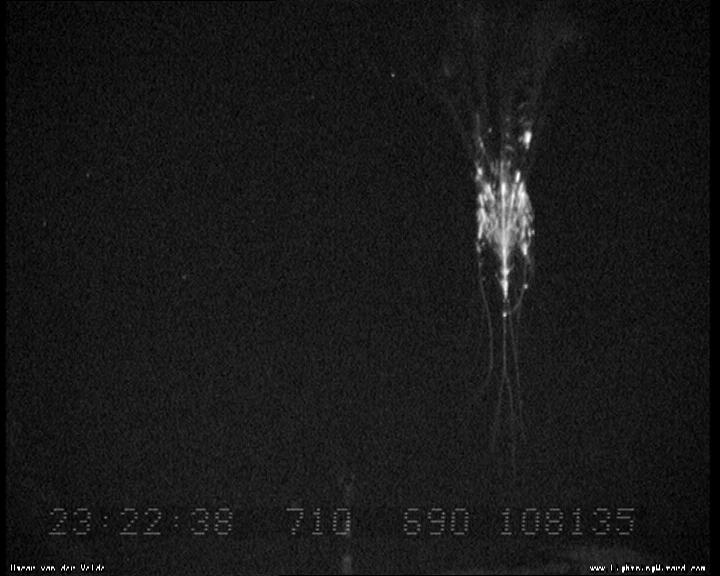This next picture gives you an idea how big this thing must be. A sprite is like a window opening into space through our atmosphere.
Over the weekend, an atmospheric scientist in Europe photographed something that resembled a giant luminous squid floating over a thundercloud in France. It was a strange form of lightning known as a "sprite":
via Strange 'Squid-like' Lightning Spotted over France | TDG - Science, Magick, Myth and History.
NASA says:
Image: Time-elapsed photography shows sprites "dance" across the horizon. Credit: University of Alaska, Fairbanks.
For centuries, man has been transfixed by the spectacular lightning displays of thunderstorms. But after all those years of gazing at the sky, we never realized there was an equally amazing light show going on above the clouds.
In our own century, pilots reported seeing strange lights in the sky above thunderstorms. Low-light cameras on board airplanes and the Space Shuttle have recently made possible the documentation of sprites - quick red flashes of light that appear above storm clouds.
Dr. Dave Sentman of the University of Alaska, Fairbanks is one among a small group of researchers who have been studying these mysterious bursts of colored light. Although no one is sure what sprites really are or what causes them, these scientists have learned that sprites contain a great deal of energy.
"Although we're not yet certain, we suspect that the energies from sprites may be sufficient to drive some novel chemical reactions," said Sentman. "The region of the atmosphere where sprites appear typically doesn't contain a lot of energy, so the energy introduced from a sprite could do some really interesting things."
For instance, there is some speculation that sprites may create nitric oxide (NO) in the upper atmosphere. Nitric oxide destroys ozone, so sprites may have some impact on the Earth's protective ozone layer.
... The brightness of sprites is about 500 to 1,000 kiloRayleighs. The cones in the retina, which see color, can barely perceive this light level.
Another NASA site:
Sometimes lightning occurs out near space. One such lightning type is the recently documented red sprite lightning, which has only been photographed and studied on Earth over the last few years. The origins of all types of lightning remains unknown, and scientists are even trying to figure out why red sprite lightning occurs at all. What is known is that as some large, positive cloud-to-ground lightning strokes occur, millisecond flashes appearing red may also occur far above in the upper atmosphere. Pictured above, a group of red sprites was photographed at high resolution.
From Skyfire.TV:
What is a sprite?
A sprite is a very brief, luminous glow that occurs in the middle atmosphere. Sprites often start around 45 miles high (in the mesosphere) and extend upwards to the edge of the ionosphere (around 55-60 miles) and sometimes downwards into the stratosphere below (to as low as 15-20 miles). They are primarily red in color, except for some bluish tinge in the downward extending tendrils. ...
How long does a sprite last?
Sprites are very brief. The portion of the event that might be visible to the naked eye often lasts less than one hundredth of a second. When using a “night vision” camera, they are visible for longer periods, but rarely more than one tenth of a second.
How big is a sprite?
Huge! Aside from stretching vertically for as much as 45 miles, the sprite can often be tens of miles across. Often sprite events comprise a series of individual sprites that occur in clusters stretching 50 miles or more across the sky. The entire volume of atmosphere enveloped by a sprite can cover thousands of cubic miles.
What causes sprites?
Lightning. Sprites are the result of extremely powerful lightning discharges sometimes occurring within thunderstorms. They are almost always triggered by a powerful positive cloud-to-ground (CG) flash which lowers massive amounts of electrical charge to the Earth. This momentarily increases the electric field in the middle atmosphere beyond the point of “dielectric breakdown.” In other words, a giant spark occurs, usually starting around 45 miles above the ground. Electrical streamers then race both downwards and upwards from that point. Though sprites may look rather “solid” in many images, when viewed through telescopes, many sprites are actually composed of networks of thin channels of electrical streamers. Only a very small percentage (<10%) of positive CGs actually produce sprites, and then, only in certain storms.
This one is also from France:
"It occurred in the area east of Perpignan (France) over a thunderstorm system that earlier passed at my location. This was just before the clouds covered the sky and ended the observations." - lightningwizard
This shot taken Oct 17, 2007 near Bolivar Missouri, USA shows a sprite above a thunderstorm (see spaceweather for another still from this same video.)


2 comments:
After some editing:
Very interesting site, with some good pictures of sprites. The descriptions are generally good, but the term “floating” in “…a giant luminous squid floating over a thundercloud in France…” is misleading. The “squid” appellation is appropriate, as the event does indeed resemble a squid, but “floating” gives the impression of being of relatively long duration, say a few seconds or even longer. In fact, the entire duration of this event was probably on the order of a few hundredths of a second or so. It would therefore be detected and recorded as more or a “flash” that is present in only one or two video frames, as it was here, than something that “floated.” This is more than a pedantic distinction, as the short duration rules out any association of these events with exotic eye witness accounts of long duration events like UFOs, etc., such as one sees on some web sites.
Did you graduate from U of Iowa?
Post a Comment